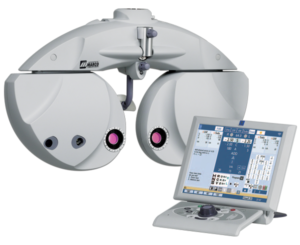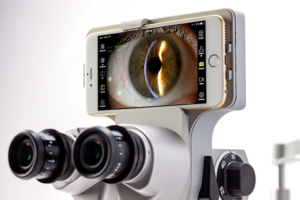Original Article Published in Women in Optometry
–
 Of her three exam lanes at Vision Source of Brandon, in Brandon, Florida, owner Laura Vizzari, OD, avoided one. It was the only one of the three that didn’t have a Marco TRS automated refraction system in it. “I was embarrassed to bring patients into it because they were used to advanced technology. It would have felt like a less-than experience for them,” she says.
Of her three exam lanes at Vision Source of Brandon, in Brandon, Florida, owner Laura Vizzari, OD, avoided one. It was the only one of the three that didn’t have a Marco TRS automated refraction system in it. “I was embarrassed to bring patients into it because they were used to advanced technology. It would have felt like a less-than experience for them,” she says.
But using it as a dilation-only room or for consultations made her realize that was ineffective. “I realized I couldn’t avoid the room anymore,” so she added the TRS to it and now has three fully functional exam spaces that she and her associate can use.
Her focus on improving the patient experience and capabilities of this practice has been at the top of her list since she acquired it in 2004, when it was an optical shop. “There was nothing else to it, so I completely rebuilt it with a focus on high-end frames and high-tech instruments,” she says.

She moved to a larger location in 2007, but she continued to work with a manual phoropter until 2012, when she added the TRS and the OPD-Scan III. Five years later, she added a second TRS system in a second lane.
“Even though we’ve been using this system for more than a decade, patients continue to be impressed with it,” she says. “I’m surprised at how often people say, ‘Remember when you used to have all those dials?’ It’s almost ancient history, but they remember that. The wow factor stays strong with this technology,” she says.
“HERE’S YOUR CHANGE”
One of the most helpful aspects of the TRS system in terms of patient flow is how easy it is to show patients the difference between their old prescription and the one from that day’s exam. “Patients want to know if there’s a change, so I can show them what the difference is. Now I can tell them, ‘If you can see a difference, then you can benefit from new eyeglasses.’ It’s amazing how much a 0.25D change can make for some people,” she says.
She knows that from personal experience. She just tweaked her own prescription for a 0.25 degree of astigmatism. “I’m really surprised by the impact. I can see so much more clearly, even with such a small numerical change,” she says.
By doing phoria testing and binocular balance with all patients, she can arrive at a more customized prescription, too. “All I do is hit one button and the chart changes. Overall, it takes less time to get to a precise prescription,” she says. It’s very helpful, she says, because “I’m ruling something out, or I’ll find new information because I chose that extra test. Patients routinely tell me they’ve never had such a thorough exam.”
These features helped increase her sales of eyewear, and it also helps get patients out of the exam lane more quickly and into the optical. If patients set aside a certain amount of time for their annual exam, the more quickly she can achieve an accurate prescription, the more time they can shift to picking out their new eyewear.
A GREAT STARTING POINT

As a part of every exam, patients stop at the Marco OPD-Scan III Visual System, a combination autorefractor, keratometer, corneal topographer, pupillometer and wavefront aberrometer. “I look at that data first,” Dr. Vizzari says. “Before I start the exam, I want to see data on their eyeglasses, their vision and their OPD. It helps me know whether I’m expecting a big change or if there’s something unusual and the data doesn’t match. It allows me to start thinking about keratoconus or know what other questions to ask,” she says.
This data is also very useful as a patient education tool. “I can show them a picture and say, ‘This is why I cannot make your vision perfect.’ Or it’s an opening to talk about specialty contact lenses,” for example, she says.
Dr. Vizzari says the amount of time that she saves with each patient compared to the days of using a manual phoropter are significant. For now, the doctors are doing the refractions, but she sees the opportunity for training a licensed optician to do the testing. “As I’m trying to expand the practice, that may be one way of increasing efficiency,” she says.
But she says she cannot imagine why some doctors are hesitant about adding the technology. “I’m surprised when I talk with a colleague who doesn’t have it. I tell them, ‘Just do it. It’s practice-changing.”
As someone who has changed the nature of an eye care business, from a generic optical shop to a full-service, high-tech primary eye care practice, she knows how much difference the right equipment can make.
Read other WO stories from Marco here.




 One of the first investments that Michelle McReynolds, OD, made when she opened cold was with the Marco OPD Scan III Wavefront Aberrometer and TRS automated refraction system. “I was looking for anything that would make my work faster because I didn’t have a technician when I first opened. It was just me doing everything,” she recalls. She opened West County Vision Center in St. Louis, Missouri, in 2011.
One of the first investments that Michelle McReynolds, OD, made when she opened cold was with the Marco OPD Scan III Wavefront Aberrometer and TRS automated refraction system. “I was looking for anything that would make my work faster because I didn’t have a technician when I first opened. It was just me doing everything,” she recalls. She opened West County Vision Center in St. Louis, Missouri, in 2011.
 After about nine years of having an automated refraction system in the practice, Heavin Maier, OD, of Eyes for Life in Spokane, Washington, couldn’t imagine practicing without it. When she added another lane of equipment, the Marco
After about nine years of having an automated refraction system in the practice, Heavin Maier, OD, of Eyes for Life in Spokane, Washington, couldn’t imagine practicing without it. When she added another lane of equipment, the Marco  The patient experience
The patient experience
 Claudio Lagunas, OD, is a builder of practices. He has owned nine—with four at one time—but now has just two. One is his established practice in Woodlands, Texas. He and his wife Grisel Lagunas, OD, recently acquired an existing practice in Spring, Texas, when the opportunity was too good not to jump at it.
Claudio Lagunas, OD, is a builder of practices. He has owned nine—with four at one time—but now has just two. One is his established practice in Woodlands, Texas. He and his wife Grisel Lagunas, OD, recently acquired an existing practice in Spring, Texas, when the opportunity was too good not to jump at it.
 Automated system for refractions brings physical relief, too.
Automated system for refractions brings physical relief, too.
 Karen Wrigley, OD, with two practices, Wrigley Eye Associates and Visual Eyes, in the Philadelphia, Pennsylvania, area, has always tried to keep her practices updated with the latest technology. Yet when she brought in new exam lane equipment from Marco recently, she was impressed by not only how it sped up the refraction and exam process but also by how much patients are enjoying the experience.
Karen Wrigley, OD, with two practices, Wrigley Eye Associates and Visual Eyes, in the Philadelphia, Pennsylvania, area, has always tried to keep her practices updated with the latest technology. Yet when she brought in new exam lane equipment from Marco recently, she was impressed by not only how it sped up the refraction and exam process but also by how much patients are enjoying the experience.
 Dr. Wrigley has seen a positive return on investment and the intangible benefit of happier customers with the Marco systems. “Our vision statement at the practice is helping patients see well and look great. The new technology has helped us achieve this,” Dr. Wrigley says. “My goal is to always keep up and push forward.” She says her patients have even noticed the office updates. Those who have jumped to another practice for their eye care often come back to her because “they know we keep up with the latest and greatest in the industry,” she says. “It is so nice that they see what I’m trying to provide for them.”
Dr. Wrigley has seen a positive return on investment and the intangible benefit of happier customers with the Marco systems. “Our vision statement at the practice is helping patients see well and look great. The new technology has helped us achieve this,” Dr. Wrigley says. “My goal is to always keep up and push forward.” She says her patients have even noticed the office updates. Those who have jumped to another practice for their eye care often come back to her because “they know we keep up with the latest and greatest in the industry,” she says. “It is so nice that they see what I’m trying to provide for them.”
 Best of all, she can conduct her exam with just as much personal attention – but at a great distance with the TRS and iON. “I’m able to sit further away than I could during earlier slit lamp examinations. Plus, it’s great for patient education,” she says. She can share the images with the patient and explain what she’s looking at, whether that’s blepharitis, dry eye, nevi or lid lesions. “It’s so much easier for the patient to understand what we can see when they look at the image. It helps show the value of what we do, especially when we can use the first day’s measures as a baseline and then show them the effectiveness of the treatment.”
Best of all, she can conduct her exam with just as much personal attention – but at a great distance with the TRS and iON. “I’m able to sit further away than I could during earlier slit lamp examinations. Plus, it’s great for patient education,” she says. She can share the images with the patient and explain what she’s looking at, whether that’s blepharitis, dry eye, nevi or lid lesions. “It’s so much easier for the patient to understand what we can see when they look at the image. It helps show the value of what we do, especially when we can use the first day’s measures as a baseline and then show them the effectiveness of the treatment.”